Utah County Birders Newsletter
|
 |
Contents
March Meeting
Upcoming Field Trips
Captain’s Log
Bird of the Month
Field Trip Report
- Delta Snow Goose Festival
Backyard Bird of the Month
February Hotline Highlights
MARCH MEETING:
Thursday, March 12th,
2015 - 7:00 pm
Dr. Clayton White, ornithologist and
emeritus professor from BYU, will present on a new book he coauthored called
"Peregrine Falcons of the World".
Meet at 7pm at the Bean Museum. 645 East 1430
North, Provo, UT http://mlbean.byu.edu/
March 6, 2015
(Fri) - 9-11am. Bird walk around Powell Lake
and Jordan River Trail. Park at Powell Lake (roughly 3250 West Willow
Reed Rd in Lehi) and we will bird around the pond and down the Jordan River
trail for a short distance. To get to Powell Lake, take Lehi Main Street West
towards Saratoga Springs. Just before you cross the Jordan River, turn left
(south) onto Willow Lane. At the "t" junction, turn right onto Willow Reed Rd
and you will see the ponds. Park along the road next to the pond.
March 14, 2015 (Sat) - 5:45am - 11am. Henefer
Greater Sage-grouse Lek and birding around East Canyon Reservoir.
Meet on the northeast end of the Harmon's Grocery Store parking lot at 5:45am to
carpool.
We are actively recruiting people to lead local half-day field
trips, any time, any place. If you would like to lead a field trip or if you
have any ideas for this year’s field trips, please contact Bryan Shirley at -
bt_shirley@hotmail.com
UCB Captain’s Log:
March 2015
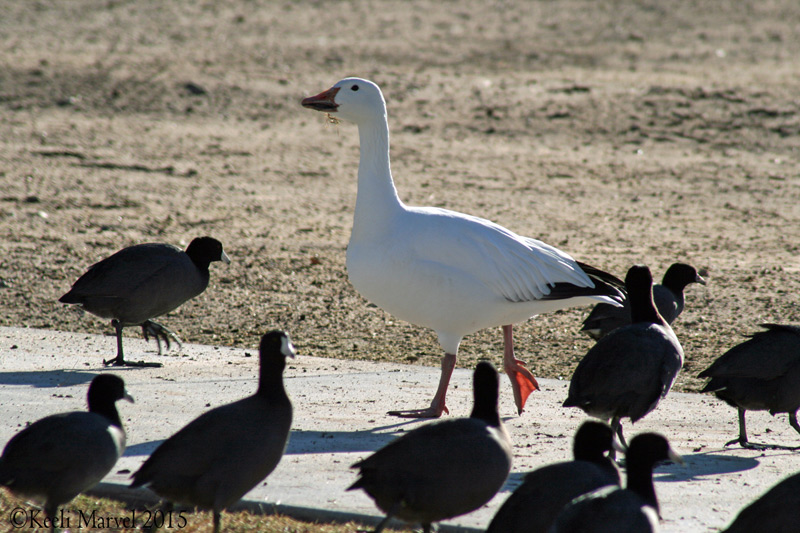 |
|
Snow Goose
from Springs Park in St. George |
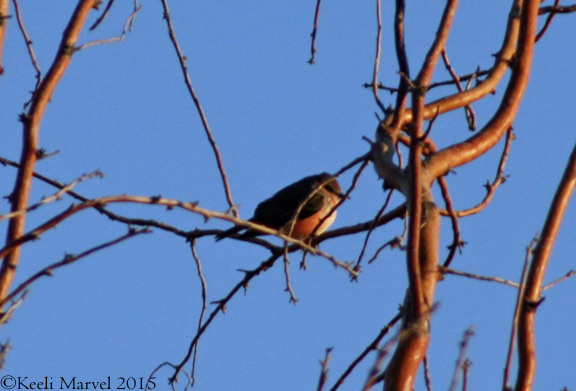 |
|
Vermillion
Flycatcher from Boots Cox Park |
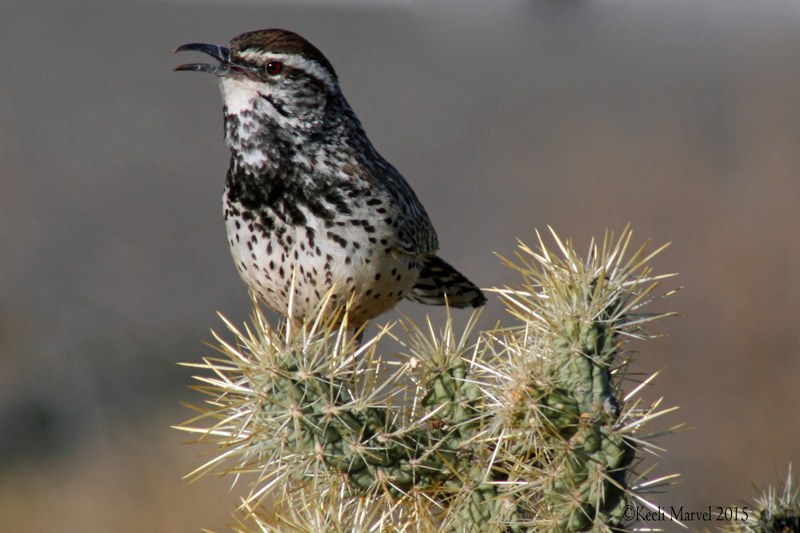 |
|
Cactus Wren
East of Sand Hollow Reservoir |
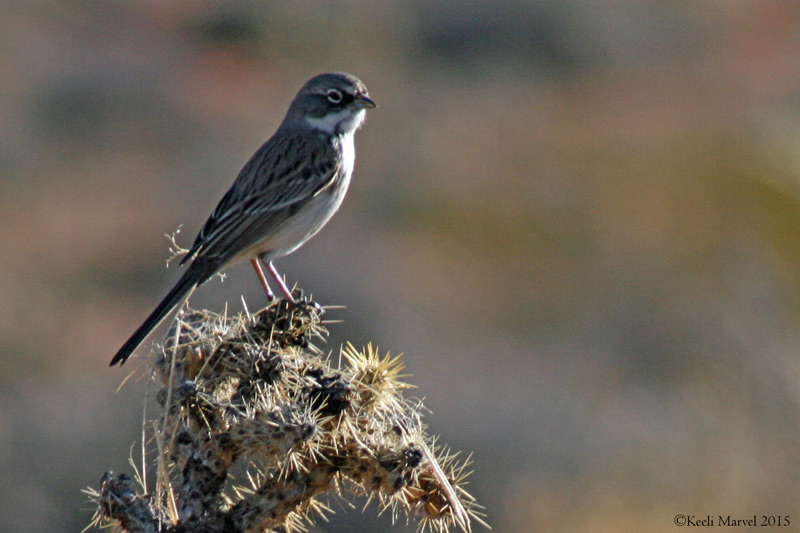 |
|
Sagebrush
Sparrow East of Sand Hollow Reservoir |
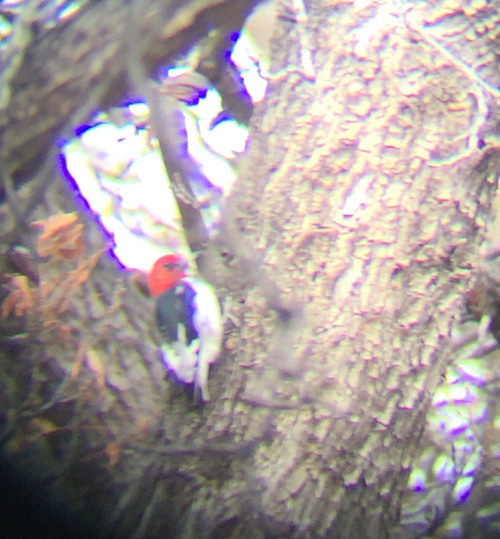 |
|
Red-headed
Woodpecker from Hurricane Pecan Grove |
by Keeli Marvel
At the end of January I ran down to Hurricane the weekend of the St. George Bird
Festival. The trip was mainly to spend time with family in the area, but I had
time to attend one of the festival field trips. The weather was miserably cold
and rainy for the entire drive down that Friday. I went for a walk in the
drizzle around the Sky Mountain golf course late afternoon when I got down there
and saw a few good birds before the drizzle turned into a steady rain again. I
saw a Say’s Phoebe, a grumpy Great Blue Heron who I kept flushing, and a damp
looking Red-tailed Hawk. I also found the large flock of American Wigeons
grazing on the grass on one of the greens. I tried but was unsuccessful in
locating a Eurasian Wigeon in the group.
The weather started out breezy and cool on Saturday, but warmed up nicely later
in the day. I joined the festival trip going to the reservoirs and fields in
Hurricane, and got to see two of my target birds. Our first stop at Quail Creek
Reservoir was pretty windy and cold, and didn’t provide much to look at. Most of
the birds were too far out on the reservoir, even for scopes, so we moved on to
Grandpa’s Fishing Pond in Hurricane. There we got great looks at Greater Scaup,
a wide assortment of other duck species, and a Bald Eagle. Our next stop, the
water treatment ponds, produced more ducks including Northern Shoveler and
Bufflehead, a Mountain Chickadee, a Red-tailed Hawk, and some Western
Meadowlarks. Following that stop we pulled into the State Park at Sand Hollow
Reservoir. There we found a Loggerhead Shrike, a few more ducks and grebes,
another Red-tailed Hawk, and around the south end of the lake, a pair of Bald
Eagles and a Prairie Falcon circling together in the sky. Our trip leader got a
call from Rick Fridell at that point saying he had eyes on the vagrant
Red-headed Woodpecker in the Pecan Grove in Hurricane, so we hurried over there
to take a look. We were rewarded with great views. This woodpecker had been
observed hanging around in the same area for several weeks and was in full color
in a tree in the middle of the grove. A few of us also got brief looks at a
Merlin in a tree along the south end of the pecan grove. That ended the field
trip on a high note for the group.
That afternoon, I headed to Boots Cox Park to try for my other target bird, the
Vermillion Flycatcher. I dipped on that one after spending about an hour at the
park (but spoiler alert- I returned later to find it!), so I headed over to the
Spring’s Pond Park/Seegmiller Marsh area and spent a good hour wandering around
the pond. At the pond I picked up a Snow Goose and three Ross’s Geese that were
keeping company with a large flock of Canada Geese. I also found a Say’s Phoebe,
a Black Phoebe, and a Cooper’s Hawk, but missed the Crissal Thrashers that
always seem to be reported there. After missing the thrasher the last several
times I’ve been to Spring’s Pond, I think I can officially say that bird is my
nemesis bird for that pond! Feeling bummed about missing the thrasher, I
returned to Boots Cox Park and was rewarded for my persistence with a Vermillion
Flycatcher perched in a tree along the fence line between the two horse
pastures. After a quick look for the Inca Doves on my way back into Hurricane
(none found), I wrapped up my birding for the day.
The next morning I got up early while everyone was still sleeping in and headed
back around the east side of Sand Hollow where I found both of my last two
target birds, Cactus Wren, and Sagebrush Sparrow. I always feel so accomplished
when I go out birding and see some great birds before breakfast. The Cactus
Wrens were very curious and kept hopping up onto cholla bushes to see what I was
doing. They gave me the opportunity to get some of the best pictures of the
trip. By the time I needed to hit the road to head home, the day had turned
pleasantly sunny and warm (of course!) I was glad for the time to spend birding
with some awesome people and getting some overdue family time. The scenery and
the nice weather down there never get old for me, and it’s always hard to hit
the freeway heading north at the end of a quick weekend break.
Happy Birding!
Keeli Marvel
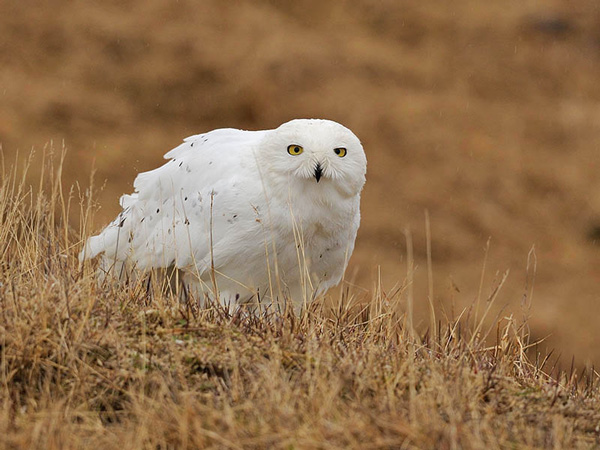 |
|
Photo by John
Crawleys |
Snowy Owl
Bubo scandiacus
by Alton Thygerson
A Snowy Owl has been reported in Utah County! When and where? December 1908 on the Provo Bench in Orem. Lynn Hayward reported this rare owl (see Footnote #1 below) and as proof, it’s in the BYU collection. This is the only substantiated record of this owl in Utah County. However, other Utah Counties (i.e., Cache, Davis, Rich) have been more fortunate with reliable sightings.
A Snowy Owl was reported last winter in Springville but it’s a questionable sighting because many reports of Snowy Owls below the Canadian border turn out to be a Barn Owl and there was no photo or collaborating witnesses. The Utah Birds website (www.utahbirds.org) gives 16 accounts of Snowy Owls in Utah. The most recent sightings were in 2013 (Cache County) and in 2011 on the Antelope Island Causeway. Excellent photographs supported both reports.
During some winters, large numbers of Snowy Owls appear south of the Canadian border. This is known as an irruption and is largely related to lack of prey—primarily lemmings and voles—being available in the north. Their appearance attracts birders as well as the media. Such was the case when I and others traveled to Montana (see Footnote #2 below).
Identification
Adults are white and large (same size as Great Horned Owl); round head; small yellow eyes; blackish bill; face is always white. The male’s plumage is usually broken with narrow, dark bars on white but older male adults are nearly pure white.
Where to look
Consider yourself lucky to spot one because these owls tend to inhabit places where humans don’t live. Pete Dunne says to “Scan all elevated points and look twice at any abrupt bumps or projections; look three times if the bump is darker than the surrounding snow.” This owl will sit for hours atop elevated perches but also sits on the ground. Examples of common perches include fence posts, utility poles, roofs, ice floes, and duck blinds. They seldom perch in trees and are most active at dawn and dusk.
Snowy Owls draw and will be harassed by other birds and harriers and kestrels will make stoops at them. Herring Gulls often circle over owls sitting on a beach. According to Pete Dunne: “Gulls tend to apportion themselves fairly evenly along a beach. A stretch of beach showing a sizable gap in the gulls is a stretch worth scanning.”
In the summer they are on the Arctic tundra; in winter they are found in open country, including prairies, farmland, coastal marshes, beaches, and large airports. In the years of lemming population booms they can raise double or triple the usual number of young.
Interesting Facts
• The Snowy Owl can be found represented in cave paintings in Europe.
• A Snowy Owl made appearances in the Harry Potter movies.
• They are diurnal—they hunt at all hours during the continuous daylight of an Arctic summer. They may eat more than 1,600 lemmings in a single year.
• They are America’s heaviest owl—about four pounds—heavier than a Great Horned Owl and twice the weight of a Great Gray Owl (North America’s tallest owl).
• The oldest-known Snowy Owl was banded in Massachusetts in 1988 and found again in Massachusetts in 2004. It was at least 16 years, 8 months old.
• John James
Audubon once saw a Snowy Owl lying at the edge of an ice hole, where it waited
for fish and caught them using its feet.
Footnote #1: The 1908 Snowy Owl in Utah County was reported by C. Lynn Hayward, a BYU zoology professor for 43 years and curator of the BYU Life Science Museum for five years. He authored 147 scientific articles and three books. He died at the age of 95 in 1998. I might add that while in a Provo used bookstore, I found and bought Hayward’s personal copy of Roger Tory Peterson’s, A Field Guide to the Birds (copyright 1939).
Footnote #2: A Snowy Owl appears on my life list and its accompanying story could qualify for insertion into a similar movie as “The Big Year” about chasing birds in North America.
In 2006 reports of Snowy Owls in Kalispell, Montana were appearing. I had expressed a desire to see one and fortunately Junece Markham overheard it. She asked if I would like to accompany she and her husband, Dixon, for a trip to Kalispell. She had access to inexpensive airline tickets which was all the more reason for going. I phoned a Kalispell birder who was hired to meet us and drive us to the owl’s site.
We left the Salt Lake City airport with a stopover in Missoula, Montana. While nearly landing on Kalispell’s runway, the pilot suddenly pulled the plane up and announced that the runway was too icy for landing and that we would go back to Missoula and wait to see if the runway’s icy condition improved. After a couple of hours in Missoula, the pilot said that another attempt to land in Kalispell would be made, but if unsuccessful, we would return to Salt Lake City. He advised that it would be best for those who had to get to Kalispell to exit the plane and get on a commercial bus going to Kalispell.
Almost all of the passengers exited and we along with a half a dozen others flew on to Kalispell. The runway had cleared and the bird guide had faithfully remained at the airport. She drove us to the Snowy Owl’s location, we took several photographs of it on top of a utility pole, and after about 30 minutes, the guide took us back to the airport. We caught an afternoon plane to Salt Lake City with another “lifer” on our lists and an experience which my sons said, “You did what?” A carload of local Utah birders drove to Montana the next week and successfully saw several of these owls.
References:
Alderfer, Jonathan, National Geographic Complete Birds of North America, Washington, D.C.: National Geographic, 2006.
The Cornell Lab of Ornithology All About Birds website: allaboutbirds.org
Dunne, Pete, Pete Dunne’s Essential Field Guide Companion, Boston: Houghton Mifflin Company, 2006.
Kaufman, Kenn, Lives of North American Birds, Boston: Houghton Mifflin Company, 1996.
If you would like to
write an article for the Bird of the Month, please contact
Machelle -
machelle13johnson@yahoo.com
Click here for past 'Birds of the Month'.
Field Trip Report
Delta Snow Goose Festival
- February 28, 2015
by Keeli Marvel
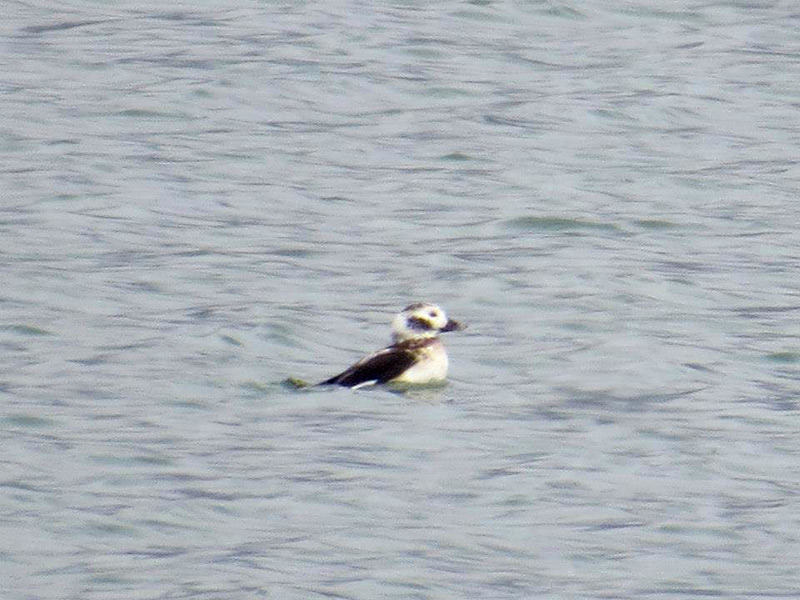 |
|
Long-tailed
Duck - Santaquin |
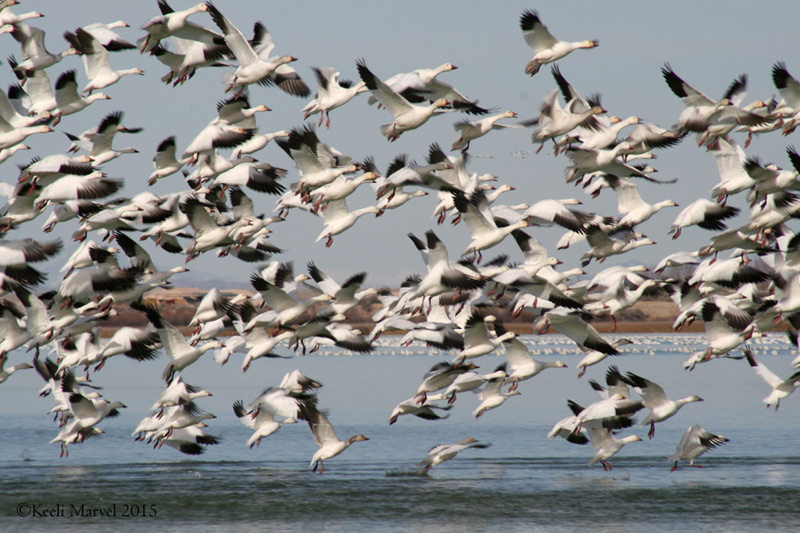 |
|
Snow Geese
taking off from Gunnison Bend Reservoir. ( 2009 festival) |
Seven of us met on the morning of Feb 28th to
attend the Snow Goose Festival in Delta. Suzi had read a report by Terrol
Williams of a possible female Long-tailed Duck in Santaquin, so our first stop
was to try and relocate that duck at the reservoir on the south end of Santaquin,
between Santaquin and the Summit Ridge neighborhood. This reservoir is known as
Summit Creek Reservoir #2. We were able to relocate the Long-tailed Duck, and
Suzi got some good pictures of it later in the day for confirmation. There were
also Ring-necked ducks, Red-head, Lesser Scaup, and a few other species on the
reservoir, and other highlights we saw in the area included a Northern Harrier,
Northern Flicker, Ring-necked Pheasant, and a Killdeer.
After that quick stop we hit the road down to Delta. At the ponds just outside
Lynndyl we saw American Wigeon, Canada Geese, and Cinnamon teal. When we got to
Delta, it had started snowing and visibility was pretty low. The Snow Geese had
not made an appearance so we drove around the agricultural fields around
Gunnison Bend Reservoir looking for Snow Geese and anything else we could find.
Highlights included a large mixed flock of Great-tailed Grackles and Red-winged
Blackbirds in a tree (not in a Walmart parking lot?!), which seemed unusual,
Canada Geese, mixed flocks of Dark-eyed Juncos and White-crowned Sparrows in the
irrigation ditches along the roads, and Horned Larks in a few of the
agricultural fields (but alas no Snow Geese). We returned to Gunnison Bend
Reservoir and soon after the geese started showing up. While we were waiting we
located a Bald Eagle perched in a tree on the far side of the reservoir. There
were quite a few ducks out on the reservoir, but because of the distance and the
snow, we were unable to identify them. The Snow Goose Festival organizers and
the Utah Division of Wildlife Resources had a couple of tents set up for the
event with a lot of educational information, festival t-shirts and other items
for sale, and fun challenges for the kids. We got pretty good looks of the snow
geese on the lake with our scopes, and lots of views of geese flying around the
reservoir. Unfortunately because of the constant snow fall, and the distance of
the birds out on the reservoir, we were unable to pick out any Ross’s geese. The
goose numbers were lower the weekend of the festival than they have been
previous weeks. This was possibly due to the warmer weather we have been having
encouraging the geese to migrate through the area a little earlier than usual.
Between the Long-tailed Duck and getting to see the Snow Geese, I’d say we had a
pretty successful trip! Thanks to the ladies who came out for it!
February 2015
Jack Binch - Sandy
Yellow-rumped Warblers that have been here all winter.
Lyle Bingham - Payson
White-breasted Nuthatch - It visited just after Christmas and it returned two months later in the company of 5 black-capped chickadees. It is about the same size and almost the same coloring: white cheeks and a longer pointy beak. However, when it jumps from the feeder to the adjacent tree and starts walking upside down, you know it isn't a chickadee and you pull out Sibley's and UtahBirds.org
Yvonne Carter - American Fork
We must have a sharpie or coopers nearby. It has been rather quiet but the usual juncos, house finches, chickadees are coming back.
Eric Huish - Pleasant Grove
White-breasted Nuthatch - Working the trees at the edge of the yard.
Only my second ever yard sighting. The first sighting (2007) was just a
fly over that then landed in the neighbors yard.
Keeli Marvel - Saratoga Springs
My backyard bird was a Great Horned Owl that I heard calling from my driveway at dusk when I got home from work a couple of weeks ago. A pair nest about a mile from my house in Saratoga Springs last year, so I was excited, but not surprised to hear one in my neighborhood.
Milt Moody - Provo
I had some rusty visitors around my feeders in Provo during February. Seven
Spotted Towhees all at once hanging out together and a pair of
Red-breasted Nuthatches.
Dennis Shirley - Elk Ridge
Downy Woodpecker -Have a pair at my suet feeder daily now.
Alton Thygerson - Provo
Downy Woodpecker - Two coming to suet feeders
Report your favorite backyard bird
each month to Eric Huish at 801-360-8777 or
erichuish@gmail.com
The Utah County Birders Newsletter is now online only/mostly.
We've decided to stop the regular paper mail version of the UCB Newsletter. This will save our club on Printing, Postage and Paper. If you would like an email notice each month when the Newsletter is posted online please send an email to Eric Huish at erichuish@gmail.com.
We are willing to print the online version of the newsletter and mail it out to anyone who still wants a paper copy or who doesn't have internet access. If you know of anyone who enjoys the UCB Newsletter but doesn't have internet access please let Eric Huish or Keeli Marvel know and we will make sure they get a copy.
Printable Version of this UCB Newsletter